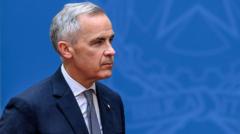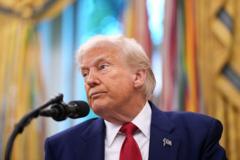As Canadians vote, polls indicate a tightening race between the Liberal and Conservative parties. With new leadership and shifting voter concerns, the outcome could redefine the country's political landscape amid external pressures.
Canadian Elections Heat Up as Polls Close on Key Decision Day

Canadian Elections Heat Up as Polls Close on Key Decision Day
Canadians cast their votes in a high-stakes election overshadowed by President Trump’s trade war, with results expected soon.
April 28, 2025, 8:45 p.m. ET
The crunch time has arrived in Canada as polls begin to shut down nationwide, fueling anticipation over who will emerge as the country's next leader amidst turbulent political waters. Recent polling suggests a fierce competition between the reigning Liberal Party, led by Mark Carney, and the opposition Conservative Party headed by Pierre Poilievre.
This election marks a turning point, transcending the usual political dynamics as escalating tensions with President Trump cast a long shadow over the campaigns. Last-minute voter sentiment appears to favor the Liberals after a tumultuous campaign season. Early indicators show a close race, instigating a surge in Liberal support due to Carney's fresh approach and the legacy issues plaguing the previous administration.
Today's electoral process also reflects a unique structure. Voters select candidates in their local electoral districts, known as ridings, while the party accruing the most seats in the House of Commons forms the governing body. A total of 343 seats are contested.
With three months of fierce rhetoric and the backdrop of Trump's aggressive trade strategies, the political narrative has shifted. Carney, a former central banker, is repositioning the Liberal Party as the bulwark against perceived threats, while Poilievre is challenged by his past affiliations that many see as parallel to Trump's policies.
Results are anticipated later in the evening, and the Canadian public watches closely as a reshaped political landscape may emerge from this pivotal election.
As the evening unfolds, the environment fosters keen interest among citizens across Canada, with the outcomes poised to influence both domestic policy and international relations considerably.
The crunch time has arrived in Canada as polls begin to shut down nationwide, fueling anticipation over who will emerge as the country's next leader amidst turbulent political waters. Recent polling suggests a fierce competition between the reigning Liberal Party, led by Mark Carney, and the opposition Conservative Party headed by Pierre Poilievre.
This election marks a turning point, transcending the usual political dynamics as escalating tensions with President Trump cast a long shadow over the campaigns. Last-minute voter sentiment appears to favor the Liberals after a tumultuous campaign season. Early indicators show a close race, instigating a surge in Liberal support due to Carney's fresh approach and the legacy issues plaguing the previous administration.
Today's electoral process also reflects a unique structure. Voters select candidates in their local electoral districts, known as ridings, while the party accruing the most seats in the House of Commons forms the governing body. A total of 343 seats are contested.
With three months of fierce rhetoric and the backdrop of Trump's aggressive trade strategies, the political narrative has shifted. Carney, a former central banker, is repositioning the Liberal Party as the bulwark against perceived threats, while Poilievre is challenged by his past affiliations that many see as parallel to Trump's policies.
Results are anticipated later in the evening, and the Canadian public watches closely as a reshaped political landscape may emerge from this pivotal election.
As the evening unfolds, the environment fosters keen interest among citizens across Canada, with the outcomes poised to influence both domestic policy and international relations considerably.






















